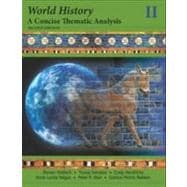
What is included with this book?
|
Volume 2
Introduction x
Unit three The Modern World 371
Themes:
Modernization
Globalization
The differential of power
Chapter 18: Spontaneous European Modernization: Phase One
The Process of Change Begins 375
Simultaneous Revolutions: Phase I, New Trade Routes / 376
Simultaneous Revolutions: Phase II, Biology and Europe / 377
Simultaneous Revolutions: Phase III, Warfare, Politics, and Religion / 380
Simultaneous Revolutions: Phase IV, Commerce / 386
Simultaneous Revolutions: Phase V, the State / 402
special topic The Elizabethan Era / 406
Suggested Reading / 413
Chapter 19: The Differential of Power: Phase One
The Americas and Africa 415
Ship Technology in 1500 / 416
Spain’s Rapid Success in the Americas after a Slow Start / 422
special topic New Spain / 422
A Hidden Agent in the Differential of Power: Disease / 423
Native American Vulnerability / 427
The Aztecs / 429
The Incas / 432
Brazil / 433
Africa’s Indigenous Slave Tradition / 435
special topic The Middle Passage: The Transport of Slaves
on the Trans-Atlantic Trip / 436
The Arrival of Europe / 439
The Sale of Slaves / 441
Consequences of the Slave Trade / 442
Suggested Reading / 446
Chapter 20: Spontaneous European Modernization: Phase Two
The Origins of Public Opinion, the Concept of Culture,
and the Nation-State 447
Science, Knowledge, and Faith / 447
The Scientific Revolution / 449
Locke’s Philosophy and the Idea of Public Opinion / 452
The Enlightenment / 458
The Nation-State / 470
The Ideology of Revolution / 472
The French Revolution / 474
Great Britain / 478
Suggested Reading / 482
Chapter 21: The Nation-State
Diffusion of the French-British Model 484
The Central European Experience / 485
Central Europeans and Internal Coherence / 487
Suggested Reading / 495
Chapter 22: The Differential of Power, Phase Two
Ideology, Medicine, and Technology Redefine Global Power 497
The New Teleology / 499
Nation-States and Industry / 510
Suggested Reading / 514
Chapter 23: Nation-State Formation outside Europe
The United States and Japan 515
The United States / 516
Japan / 525
Suggested Reading / 533
Chapter 24: Internal Divisions and Contradictions
Russia and Latin America 534
Russia / 534
Latin America / 550
Suggested Reading / 556
Chapter 25: In the Crosshairs of Modernity
India and China 557
India / 557
Late Imperial China: The Ming and Qing Dynasties / 564
Suggested Reading / 583
Chapter 26: Targets of Imperialism
Africa and the Middle East 585
Africa / 586
The Middle East / 596
Suggested Reading / 605
Unit four Global Violence and the Postmodern Era 607
Themes:
Postmodern Era
Decolonization
Globalization
Chapter 27: World War I
The Consequences of Power 611
The Illusion of Progress / 612
The Quest for Empire and the Habits of Violence / 613
Danger Signs in the Short-War Phenomenon / 615
Misunderstanding the Short-War Phenomenon / 617
World War I: Total War, the Geographic Arena of Combat, Victory, and Defeat / 618
Suggested Reading / 623
Chapter 28: Totalitarianism
The Soviet Union and Nazi Germany 624
Totalitarianism / 625
The Soviet Union / 625
special topic Abandoned Marxism / 631
special topic The Versailles Treaty / 634
Nazi Germany / 634
Suggested Reading / 641
Chapter 29: The Inheritors of Power
The United States and Japan 642
The United States / 642
Japan / 647
Suggested Reading / 655
Chapter 30: Decolonization
Phase One 656
China’s Republican Revolution / 656
India / 663
The Middle East / 665
Latin America / 670
Suggested Reading / 674
Chapter 31: World War II and the Beginning of the Cold War
Expanding the Potential of Self-Destruction 676
World War II / 676
special topic Mussolini’s Italy / 681
Mass Murder: A New Dimension to Global Warfare / 686
The Cold War: Redefining World Power after 1945 / 690
Suggested Reading / 695
Chapter 32: Global Decolonization
Phase Two 696
China / 696
Japan / 705
India / 711
Africa / 714
special topic AIDS / 721
The Middle East / 722
Latin America / 728
Suggested Reading / 737
Chapter 33: The End of the Cold War
and the Contemporary World
The Complex Problems Facing a Multicultural Era 739
The End of the Cold War / 739
special topic The Legacy of Vietnam / 743
The Contemporary World / 745
Status, Freedom, and Equality / 751
Population Dynamics / 757
Suggested Reading / 760
Credits / C-1
Index / I-1
MAPS
The Columbian Exchange and the Slave Trade / 374
The World Between World War I and II / 610
The Imperial Era (1850–1914) / 584
1945 to the Present / 740
The New copy of this book will include any supplemental materials advertised. Please check the title of the book to determine if it should include any access cards, study guides, lab manuals, CDs, etc.
The Used, Rental and eBook copies of this book are not guaranteed to include any supplemental materials. Typically, only the book itself is included. This is true even if the title states it includes any access cards, study guides, lab manuals, CDs, etc.